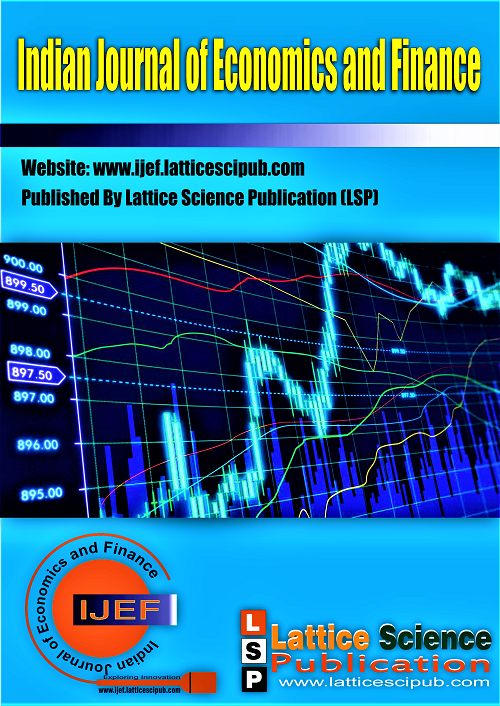Boom or bust? A Comparative Analysis of Monetary Policy and Stock Market Performance in India Across Economic Cycles
Main Article Content
Abstract
This study delves into the intricate relationship between monetary policy instruments and various sectors of the Indian stock market from 2011 to 2022. By Analyzing data encompassing significant policy shifts and economic events, including the Reserve Bank of India's (RBI) transition towards inflation targeting and flexible exchange rates, the study aims to uncover the nuanced impacts of monetary policy on sectoral indices. Utilizing a Vector Autoregression (VAR) model, the study examines the dynamic interplay between key monetary policy instruments—Cash Reserve Ratio (CRR), Marginal Standing Facility Rate (MSF), Repo Rate, Reverse Repo Rate, and Treasury Bills—and ten diverse sectors represented in the Bombay Stock Exchange (BSE) indices. The findings reveal intricate sector-specific responses to monetary policy adjustments, reflecting the complex interplay of economic dynamics and policy measures. While some sectors exhibit positive correlations with certain monetary instruments, others display negative associations, underscoring the diverse impacts of monetary policy on sectoral performance. The study highlights the significance of understanding these nuanced relationships for policymakers, investors, and market participants in navigating India's evolving economic landscape.
Downloads
Article Details

This work is licensed under a Creative Commons Attribution-NonCommercial-NoDerivatives 4.0 International License.
How to Cite
References
SINGH, A. & CMR College of Eng. & Tech. (2014). A study of Monetary Policy impact on stock market returns. In IRJA-Indian Research Journal (Vol. 1, Issue October). http://www.indianresearchjournal.com/wp-content/uploads/2014/10/Anamika.pdf
Tomar, K. S., & Kesharwani, S. (2022). Asymmetric effect of monetary policy on Indian stock market sectors: Do monetary policy stimulus transpire the same effect on all sectors? Cogent Economics & Finance, 10(1). https://doi.org/10.1080/23322039.2021.1999058
Prabu, A. E., Bhattacharyya, I., & Ray, P. (2020). Impact of monetary policy on the Indian stock market: Does the devil lie in the detail? Indian Economic Review/Indian Economic Review, 55(1), 27–50. https://doi.org/10.1007/s41775-020-00078-2
Magweva, R., & Sibanda, M. (2020). Inflation and infrastructure sector returns in emerging markets—panel ARDL approach. Cogent Economics & Finance, 8(1), 1730078. https://doi.org/10.1080/23322039.2020.1730078
Sathyanarayana, S., & Gargesa, S. (2018). An analytical study of the effect of inflation on stock market returns. IRA-International Journal of Management & Social Sciences, 13(2), 48. https://doi.org/10.21013/jmss.v13.n2.p3
Bernanke, B. S., & Kuttner, K. N. (2005). What explains the stock market’s reaction to Federal Reserve policy? the Journal of Finance, 60(3), 1221–1257. https://doi.org/10.1111/j.1540-6261.2005.00760.x
Shin, Y., Yu, B., & Greenwood-Nimmo, M. (2014). Modelling asymmetric cointegration and dynamic multipliers in a nonlinear ARDL framework. In Springer eBooks (pp. 281–314). https://doi.org/10.1007/978-1-4899-8008-3_9
Kaur, Dr. M., & Sunanda. (2020). Analysis of Monetary Policy and its Impact on Indian Economy. In International Journal of Recent Technology and Engineering (IJRTE) (Vol. 9, Issue 4, pp. 355–360). https://doi.org/10.35940/ijrte.D5006.119420
Rasa, R. (2020). Economic Development in Afghanistan. In International Journal of Management and Humanities (Vol. 5, Issue 2, pp. 25–32). https://doi.org/10.35940/ijmh.B1153.105220
Keswani, S., & Wadhwa, B. (2019). Evaluating the Impact of Macroeconomic Variable on Indian Stock Market. In International Journal of Engineering and Advanced Technology (Vol. 8, Issue 6, pp. 4427–4434). https://doi.org/10.35940/ijeat.F8972.088619
Rohilla, A. (2022). Impact of Investor Sentiment on Portfolio Return - Do Economic and Market Conditions Matter? In Indian Journal of Economics and Finance (Vol. 2, Issue 2, pp. 45–56). https://doi.org/10.54105/ijef.B2531.112222
Kanaparthi, V. K. (2024). Evaluating Financial Risk in the Transition from EONIA to ESTER: A TimeGAN Approach with Enhanced VaR Estimations. In International Journal of Innovative Science and Modern Engineering (Vol. 12, Issue 2, pp. 1–9). https://doi.org/10.35940/ijisme.B1312.12020224





